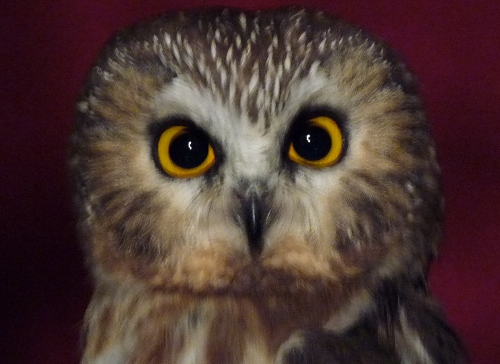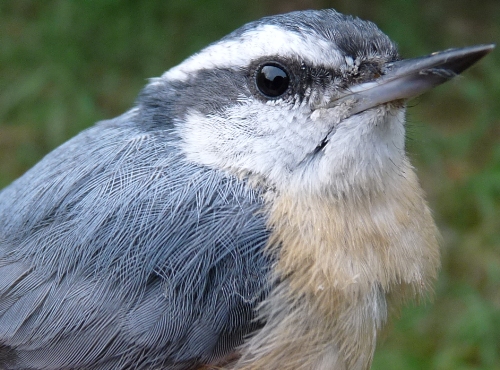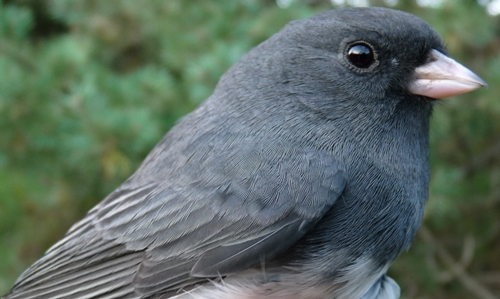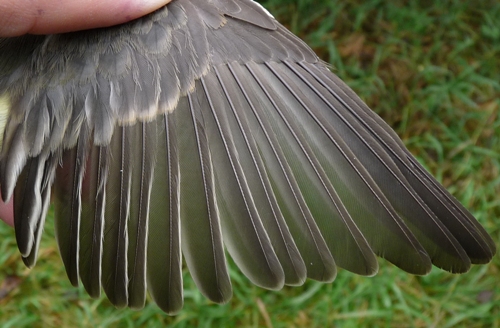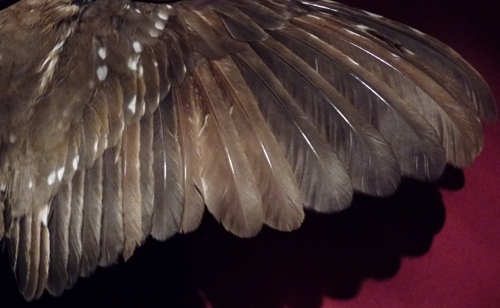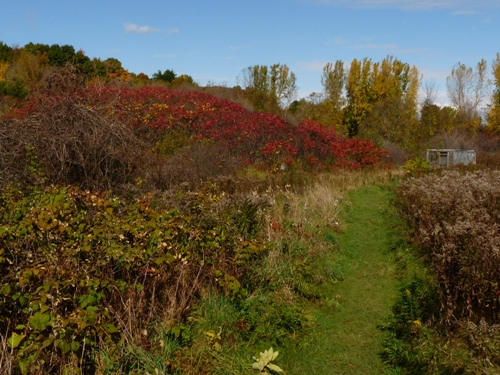|
McGILL BIRD OBSERVATORY |
|||||||||||||||||||||||||||||||||||||||||||||||||||||||||||||||||||||||||
Welcome
to the McGill Bird Observatory weekly report.
Click here for a complete listing of our archives.
Banders-in-charge: Simon Duval, Marcel Gahbauer, Gay Gruner Notes: As is sometimes the case in later fall, weather was the story of the week. For the first three days we had close to seasonal temperatures, but lost nearly half our normal net hours to rain and/or wind. However, the site was teeming with birds - an average of over 40 species observed each day, and 190 birds banded in just 136 net hours. Then on Tuesday a cold front came through, accompanied by rain, wiping out everything but census. For the remainder of the week it remained 6 - 8 degrees Celsius colder than usual for this time of year, to the extent that we had to severely curtail the opening of nets. During this part of the week our average daily count of species was down to around 30, and we banded just 66 birds in 92.5 net hours. The 22 species banded this week is a sharp drop in diversity from last week's 37, but this is actually quite typical of weeks 10 and 11 at MBO ... there is usually a big change in the bird community right around Thanksgiving. Before going on to the rest of this week's regular news, a brief tangent on the subject of owls is in order. In 2004, 2005, 2007, and again this fall we have supplemented our standardized migration monitoring program with a bit of nocturnal effort to catch and band Northern Saw-whet Owls. For various reasons, but largely due to a limited availability of qualified banders, we haven't been able to operate the owl banding program as consistently as we'd like. However, we've always felt the effort is worthwhile since there is much yet to be learned about these birds and the relatively high rate of recaptures for this species improves our chances of connecting some dots on the landscape over time (e.g. one of the birds we caught in 2004 had been banded near Kingston, Ontario three years earlier). During our three previous owl banding attempts at MBO we had modest results at best, with season totals ranging from 15 to 17 individuals banded. This fall, largely thanks to the determination of our BIC Simon Duval, we decided to give the owling another chance, but we moved the nets to a new location, near the existing E1 net, and going around and through a small fir/spruce stand. We hoped this would improve our results, but never expected the change to be as dramatic as it has been. On Tuesday night alone we banded 17 saw-whets - as many in one night as our previous best season! We also had 12 the night before, and 13 over the rest of the week, for a total of 42 (which would put them as #3 on the weekly chart below if they counted toward it). For the season we are now at 50, and we expect at least a few are yet to come. Perhaps most intriguing is that most other saw-whet banders in the northeast are reporting this to be a below average year in terms of numbers (saw-whets have quite a dramatic four-year population cycle), so we are very excited to see how our new site will fare when we have a "good" year!
Additions to our seasonal and annual lists were sparse this week. American Tree Sparrow was observed and banded for the first time this wall, while Wilson's Snipe was observed for the first time this year. We also had our first junco recapture of the year this week. Other late season species such as Northern Shrike and "winter finches" have yet to make an appearance despite the cold weather in the second half of this week, but we expect them soon.
As mentioned earlier, there tends to be quite a significant turnover of birds at MBO around mid-October, and the list of species banded most frequently this week reflects those changes. Our two late-fall specialists, American Robin and Slate-coloured Junco, have settled into the top two spots, and it would be not surprising to see them remain there (or at least close to the top) for the remaining two weeks as well. The biggest surprise this week is the continuing abundance of Hermit Thrushes, bringing our seasonal total to 80 individuals, more than double our count from any previous season (and of note we also had 19 repeats this week, many of birds we banded last week, so some are clearly hanging around and enjoying the feeding opportunities at MBO). Ruby-crowned Kinglet, White-throated Sparrow, and White-crowned Sparrow were all still reasonably numerous early in the week, but are sliding down the list as most of them moved out when the cold front arrived. Black-capped Chickadees were banded in good numbers this week, suggesting that there may be somewhat of a migration underway after all (we have seen substantial movements in "odd" years previously, but no big push of birds yet this fall). Song Sparrows continue to move in decent numbers, with this week's 12 birds bringing our season to 301, far above our normal count for them, and just one shy of the record we set in 2006.
Like last year at this time, Canada Goose numbers have tapered off a bit, while clouds of swirling American Robins have taken over the site and the top spot on the list of species most frequently observed for the week. In the second half of the week Red-winged Blackbirds were nearly as abundant as the robins, bringing them to third place for the week. The local American Crow roost appears to be building in size again, and we continued to have flocks of European Starlings fly over the site most days this week, occasionally even stopping to perch in some of the taller trees on occasion. Thanks largely to phenomenal numbers over the first couple of days of the week, White-throated and White-crowned Sparrows remain in the top 10, but are likely to drop out next week unless a large number of late migrants are waiting to move south through MBO. The surge in the arrival of Slate-coloured Juncos resulted in them being added to this week's list, and Black-capped Chickadees returned after an absence of one week, boosted a bit by the arrival of apparent migrants. Common Grackle and Yellow-rumped Warbler were the two species on the list last week that fell off this week as their numbers dropped. We have just two weeks left in this year's Fall Migration Monitoring Program, and with the cold weather of the past few days it feels in some ways like the end of the season should be coming even sooner! But we take heart in the warming trend shown in the long-range weather forecast, and hope that we'll have a good finish to the season ... no doubt with many more robins and juncos, but perhaps also a few surprises still. After all, some very northern breeders have yet to put in an appearance at MBO this fall, and with the early cold snap there may be increased opportunities to spot some of them, whether in the nets (e.g. shrikes or finches) or overhead (e.g. raptors and waterfowl).
|

